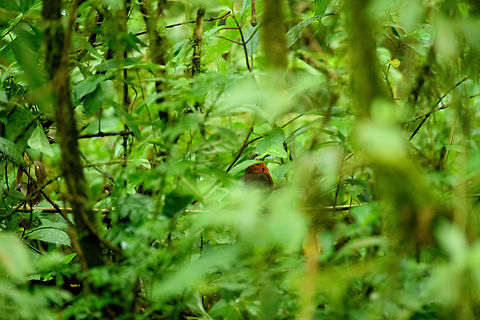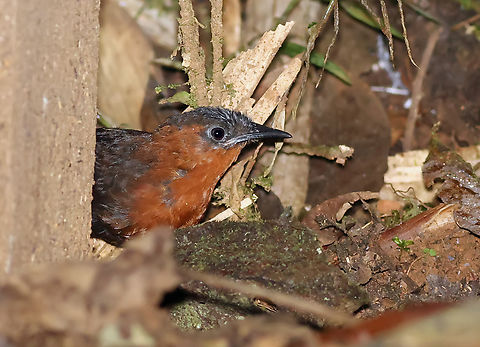
Appearance
The nominate subspecies of chestnut-breasted wren is 11.5 to 15 cm long and weighs 26.5 to 41 g. The "northern" "C. t. dichrous" is 13.5 to 15 cm long; males weigh 17.6 to 35 g and females 26.2 to 29.6 g. They appear very similar. The nominate adult has a sooty black crown, a rich dark brown back and rump, and a dark brown tail. "C. t. dichrous"'s crown is black, its back and rump very dark brown, and its tail dark brown. Both have deep orange-brown faces, throat, and upper belly and dark brown flanks and lower belly. Both juveniles differ from the adults only in having a paler lower belly.
Distribution
The "northern" "C. t. dichrous" is found in the Western and Central Andes of Colombia and south through Ecuador into northern Peru. The "southern" "C. t. thoracicus" is found in central Peru and western Bolivia.Status
The IUCN treats the two subspecies separately and has assessed both as being of Least Concern. The species is quite common in parts of Colombia, scarce in Ecuador, uncommon to locally common in Peru, and rare to uncommon in Bolivia. It does occur in several protected areas.Habitat
The chesnut-breasted wren inhabits wet montane forest including cloud forest with abundant epiphytes and moss. In elevation the "northern" subspecies usually ranges between 1,100 and 2,600 m but is found as low as 700 m on the Pacific side of the Western Andes. The "southern" subspecies is mostly found between 1,200 and 2,700 m but down to 800 m in Peru's Manú Province.Reproduction
Little is known about the chesnut-breasted wren's breeding phenology. Its nesting season appears to differ regionally; overall it is protracted. One nest in Peru has been photographed; it was a domed structure of mostly live material set very close to the ground. It contained two eggs.Food
The chestnut-breasted wren typically remains within 1 m of the ground, foraging in leaf litter for invertebrates such as beetles and spiders. It hunts alone, in pairs, or in what are assumed to be small family groups. It only rarely joins mixed-species foraging flocks.References:
Some text fragments are auto parsed from Wikipedia.